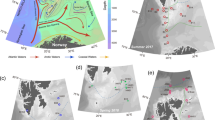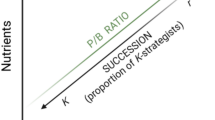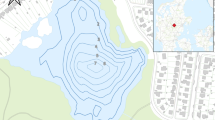Abstract
The availability and importance of food sources for growth of Daphnia longispina L. from a highly coloured fishless lake with anoxic hypolimnion were assessed by combining in situ and laboratory experiments. In in situ experiments populations were enclosed in tubes with natural temperature stratification and with or without anoxic hypolimnion. In the laboratory experiments the importance of food source (littoral zone vs pelagic epilimnion) was assessed by enclosing moss thalli and a natural zooplankton population in a large-scale flow-through system supplying food for experimental Daphnia. Growth of juveniles of Daphnia in epilimnetic water was determined in batch culture experiments and the importance of increasing concentrations of bacteria and algae for their growth and development was investigated with a small-scale flow-through system. Access to the anoxic hypolimnion enhanced the growth of Daphnia by 23–24%. Growth rates in the tubes with anoxic hypolimnion were 0.36 and 0.16 d−1 in July and August respectively. In tubes without anoxia the corresponding values were 0.29 and 0.13. In batch-cultures the highest growth rate determined was 0.16 and the overall rates were lower than in in situ experiments. In batch culture Daphnia was able to grow in darkness for 10 days with a rate of 0.16. In the large-scale flow-through system Daphnia population fed with littoral water reproduced well despite the low concentration of algae and increased its number by a factor of c. 32 in 10 days. However, the animals were small and net production of Daphnia population thus lower under the littoral influence than in the control treatment. Population could survive and grew slowly on pelagial water processed by a natural zooplankton community and with very little algae left. It is thus possible that bacteria serve as a ‘life-support system’ enabling the population survival over periods of algal shortage. Small-scale flow-through experiments revealed that Daphnia longispina is able to mature and reproduce on a bacterial diet if the food concentration is high enough and Daphnia on bacterial food could achieve growth rates similar to those on an algal diet. The threshold food level for Daphnia longispina was estimated to be c. 18.5 μg C 1−1. Detrital material is of limited value in nutrition of Daphnia even in a lake where more than 75% of carbon is bound in particulate detritus.
Similar content being viewed by others
References
Ahlgren, G., L. Lundstedt, M. Brett & C. Forsberg, 1990. Lipid composition and food quality of some freshwater phytoplankton for cladoceran zooplankters. J. Plankton Res. 12: 809–818.
Arvola, L. & P. Kankaala, 1989. Winter and spring variability in phyto- and bacterioplankton in lakes with different water colour. Aqua Fennica 19: 29–39.
Arvola, L., K. Salonen, P. Kankaala & A. Lehtovaara, 1992. Vertical distribution of bacteria and algae in a steeply stratified humic lake under high grazing pressure from Daphnia longispina. Hydrobiologia 229 (Dev. Hydrobiol. 73): 253–269.
Bergström, I., A. Heinänen & K. Salonen, 1986. Comparison of acridine orange, acriflavine and bisbenzimide stains for enumeration of bacteria in clear and humid waters. Appl. envir. Microbiol. 51: 664–667.
Børsheim, K. Y. & S. Andersen, 1987. Grazing and food size selection by crustacean zooplankton compared to production of bacteria and phytoplankton in a shallow Norwegian mountain lake. J. Plankton Res. 9: 367–379.
Børsheim, K. Y., S. Andersen, G. H. Johnsen, E. O. Kambestad & S. Norland, 1988. Primary and bacterial production compared to growth and food requirements of Daphnia longispina in Lake Kvernavatnet, west Norway. J. Plankton Res. 10: 921–939.
Brendelberger, H. & W. Geller 1985. Variability of filter structures in eight Daphnia species: mesh sizes and filtering areas. J. Plankton Res. 7: 473–486.
Cummins, K. W., M. J. Klug, R. G. Wetzel, R. C. Petersen, K. F. Suberkropp, B. A. Manny, J. C. Wuycheck & F. O. Howard, 1972. Organic enrichment with leaf leachate in experimental lotic ecosystems. BioScience 22: 719–722.
Dawidowicz, P. & C. W. Loose, 1992. Cost of swimming by Daphnia during diel vertical migration. Limnol. Oceanogr. 37: 665–669.
DeBiase, A. E., R. W. Sanders & K. G. Porter, 1990. Relative nutritional value of ciliate protozoa and algae as food for Daphnia. Microb. Ecol. 19: 199–210.
Giani. A., 1991. Implications of phytoplankton chemical composition for zooplankton production: experimental evidence. Oecologia 87: 409–416.
Gliwicz, Z. M., 1990. Food thresholds and body size in cladocerans. Nature 343: 638–640.
Gliwicz, Z. M. & W. Lampert, 1990. Food threshold in Daphnia species in the absence and presence of blue-green filaments. Ecology 71: 691–702.
Goulden, C. E. & L. L. Henry, 1983. Lipid energy reserves and their role in Cladocera. In J. R. Strickler & D. Meyers (eds), Trophic Interactions Within Aquatic Ecosystems: 167–185.
Goulden, C. E. & L. L. Hornig, 1980. Population oscillations and energy reserves in planktonic Cladocera and their consequences to competition. Proc. Acad. nat. Sci. 77: 1716–1720.
Groeger, A. W., M. D. Schram & G. R. Marzolf, 1991. Influence of food quality on growth and reproduction in Daphnia. Freshwat. Biol. 26: 11–19.
Hanazato, T. & M. Yasuno, 1985. Effect of temperature in the laboratory studies on growth, egg development and first parturition of five species of Cladocera. Jap. J. Limnol. 46: 185–191.
Haney, J. F. & D. J. Hall, 1973. Sugar-coated Daphnia: A preservation technique for Cladocera. Limnol. Oceanogr. 18: 331–333.
Hessen, D. O., T. Andersen & A. Lyche, 1989. Differential grazing and resource utilization of zooplankton in a humic lake. Arch. Hydrobiol. 114: 321–347.
Hessen, D. O., T. Andersen & A. Lyche, 1990. Carbon metabolism in a humic lake: Pool sizes and cycling through zooplankton. Limnol. Oceanogr. 35: 84–99.
Kairesalo, T., 1984. The seasonal succession of epiphytic communities within an Equisetum fluviatile L. stand in Lake Pääjärvi, southern Finland. Int. Revue ges. Hydrobiol. 69: 475–505.
Kairesalo, T., A. Lehtovaara & P. Saukkonen, 1992. Littoral-pelagial interchange and the decomposition of dissolved organic matter in a polyhumic lake. Hydrobiologia, 229 (Dev. Hydrobiol. 73): 199–224.
Kankaala, P., 1988. The relative importance of algae and bacteria as food for Daphnia longispina (Cladocera) in a polyhumic lake. Freshwat. Biol. 19: 285–296.
King, C. H., R. W. Sanders, E. M. Shotts, Jr. & K. G. Porter, 1991. Differential survival of bacteria ingested by zooplankton from a stratified eutrophic lake. Limnol. Oceanogr. 36: 829–845.
Knisely, K. & W. Geller, 1986. Selective feeding of four zooplankton species on natural lake phytoplankton. Oecologia 69: 86–94.
Kuuppo-Leinikki, P. & K. Salonen, 1992. Bacterioplankton in a small polyhumic lake with an anoxic hypolimnion. Hydrobiologia 229 (Dev. Hydrobiol. 73): 159–168.
Lair, N., 1991. Grazing and assimilation rates of natural populations of planktonic cladocerans in a eutrophic lake. Hydrobiologia 215: 51–61.
Lampert, W., 1976. A directly coupled, artificial two-step food chain for long-term experiments with filter-feeders at constant food concentrations. Mar. Biol. 37: 349–355.
Lampert, W., 1978. A field study on the dependence of the fecundity of Daphnia spec. on food concentration. Oecologia 36: 363–369.
Langeland, A., J. I. Koksvik & Y. Olsen, 1985. Postembryonic development and growth rates of Daphnia pulex De Geer and Daphnia galeata Sars under natural food conditions. Verh. int. Ver. Limnol. 22: 3124–3130.
Larsson, P., S. Andersen, Y. Borsheim, P. Jacobsen & G. Johnsen, 1985. Individual growth of Daphnia longispina in the summer decline phase of the population. Arch. Hydrobiol. Beih. Ergeb. Limnol. 21: 341–350.
Lei, C-H. & K. B. Armitage, 1980. Growth, development and body size of field and laboratory populations of Daphnia ambigua. Oikos 35: 31–48.
Lundstedt, L. & M. T. Brett, 1991. Differential growth rates of three cladoceran species in response to mono- and mixed-algal cultures. Limnol. Oceanogr. 36: 159–165.
Munro, I. G. & R. W. G. White, 1975. Comparison of the influence of temperature on the egg development and growth of Daphnia longispina O. F. Müller (Crustacea:Cladocera) from two habitats in southern England. Oecologia 20: 157–165.
Münster, U., P. Einiö & J. Nurminen, 1989. Evaluation of the measurements of extracellular enzyme activities in a polyhumic lake by means of studies with 4-methylum-umbelliferyl-substrates. Arch. Hydrobiol. 115: 321–337.
Odum, E. P. & A. A. de la Cruz, 1963. Detritus as a major component of ecosystems. Bull. am. Inst. Biol. Sci. 13: 39–40.
Pace, M. L., K. G. Porter & Y. S. Feig, 1983. Species- and age-specific differences in bacterial resource utilization by two cooccurring cladocerans. Ecology 64: 1145–1156.
Porter, K. G., 1984. Natural bacteria as food resources for zooplankton. In M. J. Klug & C. A. Reddy (eds), Current Perspectives in Microbial Ecology. Am. Soc. Microbiol.: 340–345.
Rich, P. H. & R. G. Wetzel, 1978. Detritus in lake ecosystems. Am. Nat. 112: 57–71.
Riemann, B., P. Simonsen & L. Stensgaard, 1989. The carbon and chlorophyll content of phytoplankton from various nutrient regimes. J. Plankton Res. 8: 505–517.
Rocha, O. & A. Duncan, 1985. The relationship between cell carbon and cell volume in freshwater algae species used in zooplankton studies. J. Plankton Res. 7: 279–294.
Roman, M. R., 1984. Utilization of detritus by the copepod, Acartia tonsa. Limnol. Oceanogr. 29: 949–959.
Rothhaupt, K. O. & W. Lampert, 1992. Growth-rate dependent feeding rates in Daphnia pulicaria and Brachionus rubens: adaptation to intermediate time-scale variations in food abundance. J. Plankton Res. 14: 737–751.
Ruuhijärvi, R., 1974. A general description of the oligotrophic lake Pääjärvi, southern Finland, and the ecological studies on it. Ann. bot. Fennici 11: 95–104.
Salonen, K., 1979. A versatile method for the rapid and accurate determination of carbon by high temperature combustion. Limnol. Oceanogr. 24: 127–129.
Salonen, K. & T. Hammar, 1986. On the importance of dissolved organic matter in the nutrition of zooplankton in some lake waters. Oecologia 8: 246–253.
Salonen, K. & A. Lehtovaara, 1992. Migrations of haemoglobin-rich Daphnia longispina in a small, steeply stratified, humic lake with an anoxic hypolimnion. Hydrobiologia 229 (Dev. Hydrobiol. 73): 271–288.
Salonen, K. & J. Sarvala, 1985. Combination of freezing and aldehyde fixation. A superior preservation method for biomass determination of aquatic invertebrates. Arch. Hydrobiol. 103: 217–230.
Smolander, U. & L. Arvola, 1988. Seasonal variation in the diel vertical distribution of the migratory alga Cryptomonas marssonii (Cryptophcyeae) in a small, highly humic lake. Hydrobiologia 161 (Dev. Hydrobiol. 45): 89–98.
Stich, H.-B. & W. Lampert, 1984. Growth and reproduction of migrating and non-migrating Daphnia species under simulated food and temperature conditions of diurnal vertical migration. Oecologia 61: 192–196.
Stockner, J. G., M. E. Klut & W. P. Cochlan, 1989. Leaky filters: a warning to aquatic ecologists. Can. J. Fish. aquat. Sci. 47: 16–23.
Tessier, A. J. & C. E. Goulden, 1987. Cladoceran juvenile growth. Limnol. Oceanogr. 32: 680–686.
Thompson, A. S., J. C. Rhobes & I. Pettman (eds), 1988. Culture Collection of Algae and Protozoa. Catalogue of Strains. 5th edn. Natural Environmental Research Council, UK., 164 pp.
Tulonen, T., K. Salonen & L. Arvola, 1992. Effects of different molecular weight fractions of dissolved organic matter on the growth of bacteria, algae and protozoa from a highly humic lake. Hydrobiologia 229 (Dev. Hydrobiol. 73): 239–252.
Urabe, J. & Y. Watanabe, 1991. Effect of food conditions on the bacterial feeding of Daphnia galeata. Hydrobiologia 225 (Dev. Hydrobiol. 71): 121–128.
Utermöhl, H., 1958. Zur Vervollkommnung der quantitätiven Phytoplankton Methodik. Mitt. int. Ver. Limnol. 9: 1–38.
Vijverberg, J., 1976. The effect of food quantity and quality on the growth, birth-rate and longevity of Daphnia hyalina Leydig. Hydrobiologia 51: 99–108.
Vijverberg, J., 1989. Culture techniques for studies on the growth, development and reproduction of copepods and cladocerans under laboratory and in situ conditions: a review. Freshwat. Biol. 21: 317–373.
Wetzel, R. G. & H. L. Allen, 1972. Functions and interactions of dissolved organic matter and the littoral zone in lake metabolism and eutrophication. In Z. Kajak & A. Hillbricht-Ilkowska (eds), Productivity Problems of Freshwaters. Warszawa-Krakow: 333– 347.
Author information
Authors and Affiliations
Rights and permissions
About this article
Cite this article
Ojala, A., Kankaala, P., Kairesalo, T. et al. Growth of Daphnia longispina L. in a polyhumic lake under various availabilities of algal, bacterial and detrital food. Hydrobiologia 315, 119–134 (1995). https://doi.org/10.1007/BF00033624
Received:
Revised:
Accepted:
Issue Date:
DOI: https://doi.org/10.1007/BF00033624




